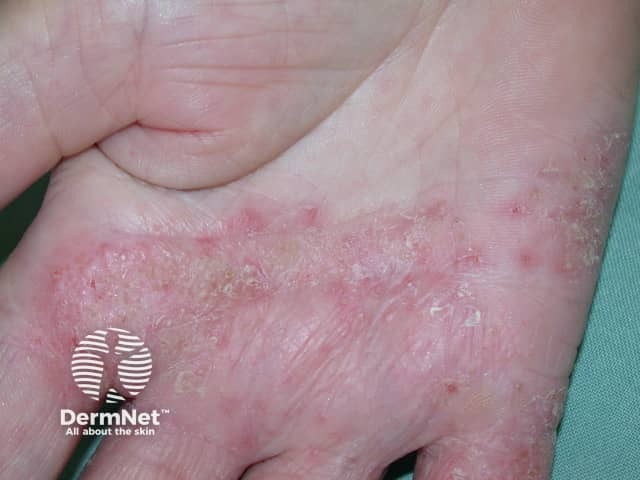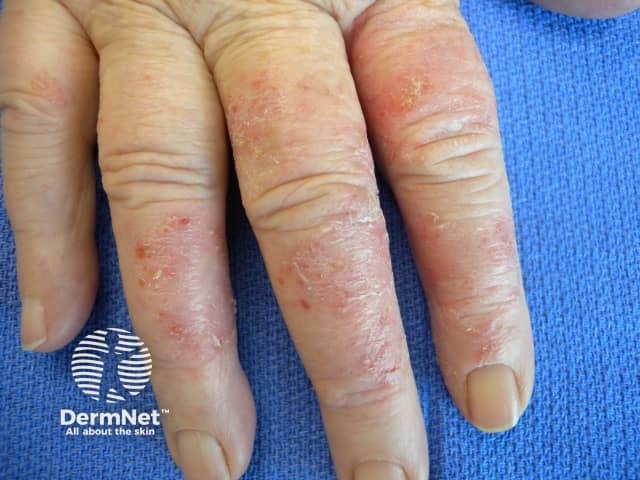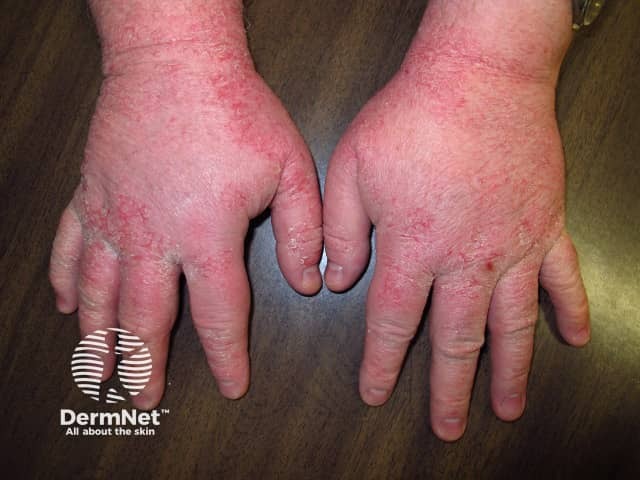Main menu
Common skin conditions

NEWS
Join DermNet PRO
Read more
Quick links
Skin problems in professional printers — extra information
Skin problems in professional printers
Author: Brian Wu PhD. MD Candidate, Keck School of Medicine; Chief Editor: Dr Amanda Oakley, Dermatologist, Hamilton, New Zealand, December 2015.
Introduction
Occupational risks
Causes
Associated skin conditons
Workplace risk assessment
Personal protective equipment
Recommended skincare
Treatment
Introduction
Those employed in the printing industry are considered to be at high risk for dermatological conditions. In the United Kingdom (UK), for instance, where printing is a major employer with over 170,000 workers in 12,000 different companies operating in this sector, the incidence of skin conditions range from 75–85 cases out of every 10,000 employees. The numbers may be greater than this, as it is believed that this problem is under-reported.
Why printers are at a greater risk
Printer workers are at particular risk of contact dermatitis, particularly on their fingertips, between their fingers and on the backs of the hands, as well as the wrists, forearms and elbows. This risk comes from exposing these body parts to the many chemicals involved in printmaking, including:
- Wash-up solution
- Formaldehyde
- Inks
- Solvents
- Alkalis
- Varnishes
- Developers
- Thinners
Particular processes within the printmaking industry also put workers at risk of contact dermatitis, including:
- Platemaking
- Correction and cleaning of lithographic plates and cylinders
- Use of solvent and UV-resistant ink
- Use of materials with isocyanates
Understanding occupational skin disease
The skin — made up of protective layers of epidermis, dermis and subcutaneous tissue — acts as a barrier against pathogens like viruses, bacteria and fungi, and against irritants and contact allergens. Exposure to such agents and mechanical injuries like cuts can compromise this barrier. Occupational skin disease is considered to account for nearly 50% of all occupational illnesses — and is responsible for around 25% of missed work days across various industries, including the printing sector.
Conditions associated with the printmaking industry
The main skin conditions arising in workers engaged in the printing industry are contact dermatitis and contact urticaria.
Contact dermatitis
Contact dermatitis is common among printmakers.
- Inflammation of the skin results from exposure to irritants and/or allergens
- Contact dermatitis can also be due to prolonged or frequent contact with water (“wet work”)
- In patients with contact allergic dermatitis, the patient develops a sensitivity to a certain chemical over the course of hours, weeks or days
- Early signs and symptoms include dry, itching or reddened skin (acute or subacute dermatitis); this can later be followed by flaking, blistering or cracking skin, swelling and discomfort or pain (chronic dermatitis)

Occupational hand dermatitis

Occupational hand dermatitis

Occupational hand dermatitis

Occupational hand dermatitis
Contact urticaria
Contact urticaria is less common than contact dermatitis.
- Contact urticaria can be due to reaction to irritants or allergens.
- The urticarial reaction will occur within minutes of contact
- Signs and symptoms include weal and flare reactions
- The best treatment is complete avoidance of contact with the responsible agent
Workplace risk assessment
Workplace assessments should be thorough and lead to measures which:
- Protect the skin, such as providing gloves, cleansers, emollients and barrier creams as well as the training to use them properly
- Educate employees to know the early signs of dermatitis or contact urticaria, so that they can seek treatment promptly
- Provide adequate risk control measures, such as substituting hazardous substances for those which are less hazardous, enclosing hazardous processes as much as possible, and use automation/mechanisation to provide distance between the employee and the process
Personal protective equipment
Appropriate gloves, hand creams and protective clothing are recommended as personal protective equipment (PPE) for workers in the printing industry. However, one study from the Health and Safety Executive in the UK found that there are several factors which make these less effective: gloves were often not used even though employers provided free access to such PPE, and they not used properly even when they were worn. The use of hand creams was deemed to be not “masculine” by male employees and in general, skin health and protection was found to be considered unimportant among employees in general.
Recommended skincare for workers in the printing industry
Recommendations include:
- Wash hands properly, especially after working with potentially hazardous chemicals
- Use mild soap and water for washing, and dry skin thoroughly afterwards
- Moisturise with pre-work and after-work creams
- Regular skin checks to look for early signs of dermatitis or other skin conditions
- Prompt and early medical treatment
Treatment of occupational skin disease
Treatment of occupational skin disease may include:
- Emollients and barrier creams
- Wet dressings for blisters
- Topical or oral corticosteroids for dermatitis
- Oral antihistamines for contact urticaria
References
- Dermatitis in the Printing Industry. Health and Safety Executive UK. 2014.
- Intervention Development in Occupational Research: an Example from the Printing Industry. Occupational Environmental Medicine. 2006. 63(4) 261–6. PubMed
- Livesly, E. J. et al. The Prevalence of Occupational Dermatitis in the UK Printing Industry. 2002. British Medical Journal. 59 (7). 487–92. Journal
- Peate, W.F. Occupational Skin Disease. American Family Physician. 2002. 66(6) 1025–33. Journal
- Preventing Contact Dermatitis and Urticaria at Work. Health and Safety Executive UK. 2013.
